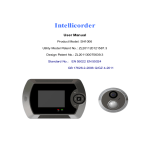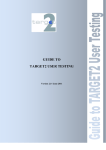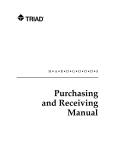Download SIBS-AT2 Interface User Manual
Transcript
Interface with SIBS-AT2
Oracle FLEXCUBE Universal Banking Europe Cluster
Release 11.3.81.02.0
[October] [2013]
Oracle Part Number E51523-01
Interface with SNCE
Table of Contents
1.
ABOUT THIS MANUAL................................................................................................................................ 1-1
1.1
1.2
1.3
1.4
2.
INTRODUCTION ........................................................................................................................................... 1-1
AUDIENCE .................................................................................................................................................. 1-1
ABBREVIATIONS ......................................................................................................................................... 1-1
CONVENTIONS USED IN THIS MANUAL ....................................................................................................... 1-1
INTERFACE WITH SIBS .............................................................................................................................. 2-1
2.1
INTRODUCTION ........................................................................................................................................... 2-1
2.2
MAINTAINING GI PARAMETER ................................................................................................................... 2-1
2.3
MAINTAINING INTERFACE DEFINITION DETAILS ........................................................................................ 2-2
2.4
INTERFACE FILE EXCHANGE ....................................................................................................................... 2-4
2.5
INTERFACE FILE SPECIFICATIONS ............................................................................................................... 2-5
2.5.1
OPI File ............................................................................................................................................. 2-5
2.5.2
OPE File ............................................................................................................................................ 2-9
2.5.3
ERR File .......................................................................................................................................... 2-11
2.5.4
TARGET2 Directory File (T2D) ...................................................................................................... 2-11
2.6
AT2 NOTIFICATION PROCESS ................................................................................................................... 2-13
2.6.1
Cancelling Transfer Transaction at AT2 Level ................................................................................ 2-16
2.6.2
Interbank Transfer Reconciliation Process ..................................................................................... 2-17
2.6.3
Cut-off Periods for Transaction Processing .................................................................................... 2-17
2.6.4
PCC (Payment Classification Code) Derivation Rule ..................................................................... 2-18
2.7
SIBS AT2-TARGET2 SUPPORT FOR SI CONTRACTS ............................................................................... 2-19
2.8
SIBS AT2-TARGET2 SUPPORT FOR OTHER MODULES ........................................................................... 2-20
3.
SCREEN GLOSSARY .................................................................................................................................. 3-22
3.1
FUNCTION ID LIST.................................................................................................................................... 3-22
1-1
1.
About this Manual
1.1 Introduction
This manual is designed to help you quickly get acquainted with interface between Oracle
FLEXCUBE and the external system, SIBS-AT2, a sub-system used to process transactions in
EUR currency and settle high value transfers.
1.2 Audience
This manual is intended for the following User/User Roles:
Role
Function
Back office clerk
Input functions for contracts
Back office managers/officers
Authorization functions
Product Managers
Product definition and authorization
End of day operators
Processing during end of day/ beginning of day
Financial Controller / Product Managers
Generation of reports
1.3 Abbreviations
The following abbreviations are used in this User Manual:
Abbreviation
Description
SIBS
Portuguese Electronic Clearing House
AT2
Payment system based on TARGET2 messages. Managed and operated by
SIBS.
TARGET2
TARGET2 is the Trans-European Automated Real-time Gross Settlement
Express Transfer System. This is an interbank payment system for the realtime processing of cross-border transfers throughout the European union area.
1.4 Conventions Used in this Manual
Important information is preceded with the
symbol.
1-1
2.
Interface with SIBS
2.1 Introduction
Oracle FLEXCUBE interfaces with the external system SIBS-AT2, which is the bank’s sub-system
to communicate directly with transaction counterparty banks to send TARGET2 messages to/from
Portuguese clearing house SIBS and receive TARGET2 messages from SIBS in a proprietary
ASCII format. It processes transactions only in EUR currency.
For all the outgoing messages SIBS-AT2 converts the proprietary messages to the standard
TARGET2 message. Incoming standard TARGET2 messages are first received by SIBS-AT2 and
are delivered to the recipient bank in Portugal after transforming it to AT2 proprietary format.
You can directly send or receive TARGET2 transactions to or from SIBS-AT2 and settle the
payment transactions through RTGS accounts.
Oracle FLEXCUBE supports the following AT2-TARGET2 messages:
MT103 (Single Customer Credit Transfer
MT103+ (Single Customer Credit Transfer-STP)
MT202 (General Financial Institution Transfer)
MT202COV (General Financial Institution Cover Transfer)
TARGET2 Directory update Message
ERR File
Nostro Reconciliation related messages are directly received by the bank in SWIFT MT Message
format.
The following maintenances have to be done for the interface to work:
Maintaining GI Parameter
Maintaining Interface Definition Details
2.2 Maintaining GI Parameter
You can set the parameters for the framework of Generic Interface processing in the following
screen ‘Parameters’ screen invoked from the Application Browser. You can invoke this screen by
typing ‘GIDPARAM’ in the field at the top right corner of the Application tool bar and clicking the
adjoining arrow button.
2-1
You can maintain the following parameters for generic interface here.
Holiday Treatment
You can specify the parameters for interface processing if the schedule date falls on a holiday.
Holiday Treatment
Check this box to indicate your preference for interface processing on a holiday.
Next Run Date
Specify how the system should process if the schedule date falls on a holiday. You can select the
options as either move the interface processing to previous working date or next working date if
the interface processing day falls on a holiday.
Note the following:
This branch holiday calendar will be SNI (National Interchange Subsystem) calendar for
Spain banks
The default holiday treatment is movement to ‘next working date’.
For more details refer section ‘Maintaining GI Parameter’ in Generic Interface User Manual.
2.3 Maintaining Interface Definition Details
You can define the format details and properties associated with interface file in the ‘Interface
Definition’ screen. For both Incoming and Outgoing files, the file structure is defined here
You can invoke this screen by typing ‘GIDIFTDF’ in the field at the top right corner of the
Application tool bar and clicking the adjoining arrow button.
2-2
You can define the following interface file properties, formats and components here.
Branch Code
Specify the code of the branch to which the interface belongs.
Interface Type
Select the interface type from the following options:
Incoming - Select this option if the file data needs to be uploaded into Oracle FLEXCUBE
Outgoing - Select this option if data from Oracle FLEXCUBE needs to be written into file
For more details refer section ‘Specifying Interface Definition Details’ in Generic Interface User
Manual.
For incoming interface definition and outgoing interface definition the following details have to be
maintained in the ‘Interface Definition’ screen.
Incoming definition for the incoming interface definition type
Format type: This will always be ‘Fixed’ as there is no delimiting character.
File path: This will be data bases server path where incoming file will be placed
(FLEXCUBE will append /ready to the mentioned path and expects file also in the same
path e.g. if path is mentioned /SNCE05 and FLEXCUBE expects file in /SNCE05/ready).
Outgoing definition for the outgoing interface definition type -.
File path: This will be data bases server path where incoming file is placed (FLEXCUBE
will append /ready to the mentioned in this field and writes file also in the same path).
Pre field UDF: this field is in component field linkage section and this can be used to
arrive at LOT record total fields , fields such as Total amount, total commission amount
etc., please refer the field mapping excel for field level details
2-3
File mask: File naming will be based on this field and data in each parameters has to be
followed by a “/ “ or ” $” where values mentioned in the mask after ” / “will be used as it is
and values mentioned after $ contains different characteristics as given below.
B : Branch code
U : User ID
D : Date from application date
M : Month from application date
Y : Year from application date
h : Hour from application date
m : minute from application date
s : second from application date
2.4 Interface File Exchange
SIBS-AT2 TARGET2 platform exchanges transaction data with the participant banks in bulk files.
Following are the list of AT2 ASCII files exchanged as part of inward and outward transactions:
SL No.
File Name
Incoming/
Outgoing
Sender
Receiver
File Description
1
OPI
Outgoing
Bank
SIBSAT2
OPI file contains following types
of CT and CT related messages:
Outward transfers
Outward transfer
cancellation requests
In case of transfers, this file
contains following transfer
transactions within Euro zone.
Following are the corresponding
TARGET2 payment messages
involved.
2
OPI
Outgoing
Bank
SIBSAT2
MT103
MT103+
MT202
MT202COV
This file contains the outward
TARGET2 messages for Nostro
credit related reconciliations. This
file can either be send as an
independent file or it can be
included in the normal outgoing
‘OPI’ file mentioned above.
The Nostro credit
reconciliation mentioned above is
not related to Oracle FLEXCUBE
Nostro Reconciliation module.
2-4
SL No.
File Name
Incoming/
Outgoing
Sender
Receiver
File Description
This is a SIBS inward funds
transfer specific process wherein
beneficiary bank is not clear on
the purpose and other details of
the funds received.
3
OPE
Incoming
SIBSAT2
Bank
This file contains following types
of transaction messages:
The inward transfer transactions
(including pass-through cases)
from banks within Euro zone.
AT2 transaction status notification
messages.
Following are the incoming
TARGET2 payment messages
involved.
MT103
MT103+
MT202
MT202COV
4
ERR
Incoming
SIBSAT2
Bank
SIBS-AT2 platform sends this file
to participant banks as a
response to the outward ‘OPI’ file
received.
5
T2D
Incoming
SIBSAT2
Bank
SIBS-AT2 periodically sends the
updates on the TARGET2
directory which contains the latest
status of participating banks in the
system. Oracle FLEXCUBE
needs to process the incoming file
and update its TARGET2
directory accordingly.
2.5 Interface File Specifications
2.5.1 OPI File
OPI file is an outgoing file which contains outward transfer transactions in EUR where the
beneficiary bank is located within the Euro zone. Outgoing payment messages is included in this
file in SIBS-AT2 specific formats defined for MT103, MT103+, MT202 and MT202COV SWIFT
MT messages.
The records available in the outgoing OPI files are:
Header Record
Details Record
2-5
Addenda Record
Trailer Record
The OPI file structure is as below:
‘Details’ record contains the main transaction data of a transfer. The OPI file also contains
multiple ‘Addenda’ records which contains additional transfer transaction information.
Following table contains the maximum number of ‘addenda’ records that can be included as part
of applicable TARGET2 messages:
Message
Type
Maximum Number of
Addenda Records
MT103
10
MT103+
10
MT202
04
MT202COV
09
The generated outward OPI file should be moved to a designated folder within Oracle
FLEXCUBE infrastructure from where the external systems or users can pick it up for
transmission to AT2. Before generating the bulk OPI file to transmit to AT2, individual AT2
transaction messages should be manually authorized by bank user. After the authorization of all
the individual messages, system will generate the OPI file for transmission.
In an OPI, file records will be arranged in the following order:
File Header
MT103 Transactions with Addenda
MT103+ Transactions with Addenda
MT202 Transactions with Addenda
MT202COV Transactions with Addenda
Cancellation Messages
Reconciliation Messages
2-6
File Trailer
You can generate an OPI file if:
Authorized outward FT credit transfer contracts are available with same day or next day
as value dates
Authorized outward FT credit transfer cancellation requests
Authorized inward FT transactions with reconciliation statuses as ‘For Reconciliation’ or
‘Reconciled’
‘Resident or ‘Non-Resident’ status of the banks involved in a SIBS AT2-TARGET2 outward RTGS
funds transfer is derived based on the ‘country code’ of the corresponding BIC. If the country
codes of both sender and receiver banks are same, it will be classified as a funds transfer
between resident banks. If the country code of receiving bank is different from that of the sending
bank, it will be termed as a transfer between a resident and non-resident bank.
When the generated OPI file is sent by the bank to SIBS for processing, another round of manual
authorization will be done at ‘SIBS Bank interface Application’. If any cancellation is required for a
transaction, the bank user will not authorize the same at ‘SIBS Bank interface Application’ so that
it is not processed at SIBS end. If the cancellation request should be send to SIBS before the
processing cut-off time it should be ensured manually through ‘TARGET2 Transaction
Maintenance’ screen before the transaction cut-off time.
For reconciliation related transactions cut-off time is not applicable.
While generating outward OPI file, the system populates the corresponding file fields with
respective parameter values. The following are the parameters to be captured at the
parameterization level:
Sl
No
Parameter / Field
Name
Parameter Description and
Location
Applicability and Format
1
CDP Code
Reference code assigned by
SIBS to the data processing
centre of the bank.
CDP code should be included
as part (first part is bank code)
of the field ‘ID-EMISS – File
issuer identification’ of file
header (HDT=0).
This parameter value will be
maintained as GI interface
definition default value.
2
Identification Code
of OPI File
Recipient
In case of outward OPI file
recipient is always SIBS and
this parameter holds the SIBS
identification code.
This parameter value will be
maintained as GI interface
definition default value.
3
4
Internal
Communication
Origin ID
AT2 Operation
This indicates the origin of
internal communication.
This parameter value will be
maintained as GI interface
definition default value.
This field holds the default
2-7
This is a 2 digit number.
SIBS identification code
should be included as part of
field ‘ID-DEST-File recipient
identification’ of file header
(HDT=0).
This is a 6 digit number.
Internal Communication Origin
ID should be included as part
of field ‘ORI-INT’ of the ‘Detail
Header Record’ (HDT=2).
This is a character 5 field.
AT2 Operation Status
Sl
No
Parameter / Field
Name
Parameter Description and
Location
Applicability and Format
Status Indicator
status of a transaction record
included in the outward OPI
file.
Indicator should be included
as part of field ‘ESTADO’ of
the ‘Detail Header Record’
(HDT=2).
This parameter value will be
maintained as GI interface
definition default value.
This is a character 2 field.
Default status should be
included as 'I5' – The
operation is inserted with a
Pending status in AT2’.
This status is applicable for
following types of transactions
included in the OPI file:
5
AT2 Operation
Status Indicator for
Cancellation
Request
This field holds the default
status of a credit transfer
cancellation request record
included in the outward OPI
file.
This parameter value will be
maintained as GI interface
definition default value.
6
Separate OPI File
Required for
Reconciliation
Messages
This is required in case bank
wanted to generate separate
outward OPI file for Nostro
credit reconciliation related
messages.
This parameter will be defined
at the ‘Bank Parameter Level’
and will be part of
CSTB_PARAM table. Field
name is
‘SEPARATE_REC_FILE ’
7
TARGET2 Payment
Message Format
Applicable at
Branch level
This parameter helps the bank
to configure the type of
TARGET2 payment messages
format applicable for MT103,
MT103+, MT202 and
MT202COV messages.
Message formats has to be
either standard individual
TARGET2 message format or
2-8
Outward credit
transfer records
Outward transfer
reconciliation records
AT2 Operation Status
Indicator for cancellation
request should be included as
part of field ‘ESTADO’ of the
‘Detail Header Record’
(HDT=2).
This is a character 2 field.
Default status should be
included is 'I7' – To Cancel an
operation in AT2’.
If this parameter is set i.e.
value is updated as ‘Y’,
system will generate separate
OPI file which contains only
nostro credit reconciliation
messages.
If this parameter is not set (i.e
default value which is ‘N’)
system will include
reconciliation messages also
in the common OPI file.
Based on this parameter
value system generates either
standard individual TARGET2
or SIBS AT2-TARGET2
formats for MT103, MT103+,
MT202 and MT202COV
outward payment messages.
By default this parameter will
be set as ‘N’ meaning in case
Sl
No
Parameter / Field
Name
Parameter Description and
Location
Applicability and Format
SIBS AT2-TARGET2 message
format.
of this branch, standard
individual TARGET2 payment
messages will be generated
for outward MT103, MT103+,
MT202 and MT202COV
payment messages.
This parameter is available as
part of Branch Parameters
Maintenance (STDBRANC).
Branch Parameters
Maintenance ->Financial
Details -> Payment Messages > SIBS AT2-TARGET2 (Y/N)
This parameter value has been
stored in the field
SIBSAT2_PROCESSING of
table STTM_BRANCH_C
If the ‘SIBS AT2-TARGET2’
check box is checked,
parameter value will be
changed to ‘Y’, meaning in
case of this branch SIBS AT2TARGET2 payment
messages will be generated
for outward MT103, MT103+,
MT202 and MT202COV
payment messages.
This is a check box.
2.5.2 OPE File
OPE file is an incoming file received by the clearing participants from SIBS. OPE file has the
following types of transaction information:
Incoming transfers from SIBS (Domestic Transfers in EUR – Within Portugal)
Incoming transfers received from TARGET2 (Cross Border Transfers in EUR – Within
Euro zone)
Notifications from SIBS AT2 platform
OPE file contains following funds transfer messages:
Customer Transfers (MT103, MT103+)
Interbank Transfers (MT202)
Interbank Transfers with Cover (MT202COV)
The records available in OPE file are:
Header Record
Details Record (Transaction Details)
Addenda Record (Addenda header + Addenda data + space filling)
Trailer Record
The OPE file structure is as below:
2-9
‘Details’ record contains the main transaction data of a transfer. In addition to the ‘Details’ record,
OPE file also contains multiple ‘Addenda’ records which contains additional transfer transaction
information. Each individual transfer transactions inside the OPE file can have its own number of
'addendas'.
Following table contains the maximum number of ‘addenda’ records that can be included as part
of applicable TARGET2 messages:
Message
Type
Maximum Number of
Addenda Records
MT103
10
MT103+
10
MT202
04
MT202COV
09
Incoming OPE file will be available in a designated folder within Oracle FLEXCUBE infrastructure
from where it can be picked up for processing. Once Oracle FLEXCUBE creates the individual
transaction messages (E.g. MT103, MT103+, MT202 or MT202COV) out of the received OPE
file, it needs a user authorization before creating the corresponding FT contracts in FT module.
These FT contracts also require manual authorization by a bank user i.e. Oracle FLEXCUBE
creates only non-authorized FT contracts as part of the incoming payment message
authorization.
You can automatically upload the OPE file once it is copied to the specified incoming file location
of Oracle FLEXCUBE infrastructure. After upload the system populates the ‘MT Message
Browser’ screen with individual transaction messages included in the file. The transaction
messages include:
Incoming payments
AT2 Transaction Status Notification
While processing an OPE file the system creates log details for each of the OPE file processed.
You can view this log details in the ‘Files Upload Details’ sub-screen of the MT Message browser
Summary screen.
2-10
For Oracle FLEXCUBE to process the incoming OPE file, it should be copied to the designated
folder within FLEXCUBE infrastructure by adding ‘SIBSOPE’ with the file name format. For
example ‘SIBSOPE_YYYYMMDDSS.txt’ where "YYYY” is the year, “MM” is the month and “DD"
is the day of the current date, and "SS" is the sequence indicator generated sequentially by File
Transfer Protocol. This indicator consists of a sequence number of 01 to 99, restarting in 01 after
reaching 99.
2.5.3 ERR File
The participant banks in SIBS-AT2 in Portugal send the outward OPI file to SIBS for processing.
After validation of the received OPI file, SIBS sends the ERR file with the validation results. If
there are no errors detected, then the SIBS send the ERR file as an acknowledgement. In case of
errors, Oracle FLEXCUBE needs to display the errors i.e. the contents of the ERR file so that
bank user can take the necessary corrective actions to re-transmit the transactions post
rectification.
The ERR File consist of the following records:
Header Record
Details Record
Trailer Record
2.5.4 TARGET2 Directory File (T2D)
TARGET2 directory helps the clearing participants to set the payment routing instructions
correctly and there by execute the fund transfers through SWIFT network. The TARGET2
Directory is a product of the Euro system and consists of a list of SWIFT addresses of financial
institutions participating in the TARGET2 clearing network. These institutions may be direct or
indirect participants, addressable BICs or multi-addressees. The directory is updated on a weekly
basis and is distributed through SWIFTNet FileAct to the direct participants in the system.
T2D file is does not have header and trailer records. Structure of the file is as below:
Field Name
Nature
Data Type
Description
BIC
Mandatory
BIC 11
BIC of the Participant
Address
Mandatory
BIC 11
BIC to be used in the header of the
SWIFT message
Account
Holder
Mandatory
BIC 11
BIC of the settlement bank
Institution
Name
Mandatory
105x
Participant company name
City Heading
Mandatory
35x
Head office
2-11
National
Sorting Code
Optional
15x
Participant code in the national system
Main BIC
Flag
Optional
1x
The possible values are:
Y - Yes
N - Not
The "Y" means that the BIC can be
used to address payments if the payer
does not provide other information to
send
Type of
Change
Mandatory
1x
The possible values are:
A – Added (Will appear in case a new
record is issued in the current version
of the TARGET2 directory. New record
must be added to FLEXCUBE);
M – Modified (Indicates that a field
(different from the BIC) is changed in
the current version compared to the
previous one. FLEXCUBE will
overwrite the existing record with the
new one);
D – Deleted (Indicates the deletion of a
BIC from the TARGET2 directory. It
will be no more reachable in the
platform. The existing record will be
deleted from FLEXCUBE. It must be a
logical deletion - mark the record as
deleted);
U – Unchanged (Indicates that no
changes are made in the current
version of the TARGET2 directory with
respect to the previous one.
FLEXCUBE should ignore);
Valid from
Mandatory
YYYYMMDD
Date from which registration is valid
Valid till
Mandatory
YYYYMMDD
Date till which the registration is valid
(if not specified is equal to '99991231')
2-12
Participation
type
Mandatory
2x
The possible values are:
01 - Direct
02 - Indirect
03 - Multi addressable (Credit
Institutions)
04 - Multi addressable (Branch of
direct participant)
05 - Addressable BIC (Correspondent)
06 - Addressable BIC (Branch of a
direct participant)
07 - Addressable BIC (Branch of an
indirect participant)
08 - Direct Participant T1
09 - Indirect participant T1
Reserve
O
23x
Reserved filler
2.6 AT2 Notification Process
The outgoing transfers are sent to SIBS-AT2 platform through OPI file and incoming transfers are
received through OPE file. Through the notification process, AT2 platform intimate the participant
banks regarding the processing status of an inward or outward transfer transaction.
When an outward transfer transaction message or transfer cancellation message is included in an
outward OPI file, the originating bank uses following status codes:
Status
Code
Status Description
Field Details
I5
The transfer transaction is included
with a ‘pending’ status in AT2.
Field: ESTADO
I7
To cancel an operation in AT2
Record: Detail Header
Record
Every individual transaction in an OPI or OPE file will receive a notification message based on the
processing status in AT2. But it is not necessary that AT2 will send a notification for all types of
transactions. Following table explains the conditions on which notification messages will be
received:
2-13
Participant
to AT2
Transaction
Validation at
AT2
Previous
Status
I5
OK
--
AT2
Pending
No
--
I5
ERROR
--
Incomplete
Pending
No
--
I7
--
Incomple
te
Pending
Cancelled
Yes
A7
I7
--
AT2
Pending
Cancelled
Yes
A7
I7
--
Schedule
d
Cancelled
Yes
A7
(message
status)
Next Status
Participant Bank
is Notified?
AT2 to
Participant
(message
status)
The list of status codes provided by the AT2 platform through the notification messages are as
follows:
S1– Operation was successful, accepted and settled in TARGET2.
A5 – Operation updated to pending status. Operation needs authorization to proceed to
TARGET2.
S5 – Operation was Rejected in TARGET2 (insufficient funds in the debtor account).
S6 – Operation was revoked in TARGET2. Operation was revoked in TARGET2 by the
Originator Bank.
A7 – Operation was cancelled in AT2. Operation was cancelled in AT2 by the Originator
Bank.
The table below provides the details of internal transaction status changes and corresponding
notification status to participating banks:
Action in
Previous
AT2
Status
Next AT2
status
Insertion
--
Incomplete
Pending
No
--
Insertion
--
AT2 Pending
No
--
Confirmation
Incomplet
e Pending
AT2 Pending
Yes
A5
Cancellation
Incomplet
e Pending
Cancelled in
AT2
Yes
A7
AT2/TARGE
T2
Participant Bank
Notified?
AT2 to
Participant
(message status)
2-14
Action in
Previous
AT2
Status
Next AT2
status
Authorization
AT2
Pending
Scheduled
No
--
Cancellation
AT2
Pending
Cancelled in
AT2
Yes
A7
Cancellation
Scheduled
Cancelled in
AT2
Yes
A7
Sent to
TARGET2
Scheduled
Stored
No
--
TARGET2
Settlement
Stored
Final
Yes
S1
TARGET2
Revoked
Stored
Revoked
Yes
S6
TARGET2
Rejected
Stored
Rejected
Yes
S5
AT2/TARGE
T2
Participant Bank
Notified?
AT2 to
Participant
(message status)
AT2 sends the notification message to the participant bank as part of incoming OPE files without
any transaction addenda.
Oracle FLEXCUBE will then update its FT contracts with the above mentioned status code as and
when a notification message is processed. After processing there should be a provision to view
the contents of the notifications messages on Oracle FLEXCUBE screens.
2-15
2.6.1 Cancelling Transfer Transaction at AT2 Level
When the outward OPI file is generated in Oracle FLEXCUBE, it is transmitted to SIBS-AT2
through the AT2 application. As per the transaction processing workflow at SIBS-AT2, the
transactions included in the transmitted OPI file should be authorized through the bank interface
application of AT2. SIBS-AT2 will process only those credit transfer transactions which are
authorized by the bank user at AT2 bank interface application.
After transmission to AT2 platform, the originating bank can initiate a cancellation request for a
credit transfer transaction included in the transmitted OPI file. Cancellation request can be raised
under to the following conditions:
Transaction to be cancelled is not yet authorized by the bank user at AT2 bank interface
application.
If the AT2 processing status of the transaction are the following:
S1 – Operation was successful accepted and settled in TARGET2
S5 – Operation was Rejected in TARGET2
S6 – Operation was revoked in TARGET2
A7 – Operation was cancelled in AT2
If AT2 executed the cancellation request successfully, it is informed to the originating
bank in the form of a notification message in the OPE file.
If AT2 rejected the cancellation request, it is informed to the originating bank as an error
through the ‘ERR’ file.
2-16
2.6.2 Interbank Transfer Reconciliation Process
The banks in Europe sends and receives EUR funds through TARGET2 system. When the bank
receives a credit at its Nostro account from another bank and the beneficiary bank is not sure
about the purpose or associated transaction details, then it declares the received credit as ‘for
reconciliation’. The beneficiary bank will then include a ‘reconciliation’ message 1363 in the form
of a ‘Detail header record – HDT=2’ without any addenda in the outward OPI file. While sending
the reconciliation message, ‘DEBCRE’ (Dr/Cr indicator) of ‘Detail Header Record’ should be filled
with the value ‘C’ (credit) and ‘NAT-OP’ should be filled with the value ‘0’ (zero).
When the bank receives a credit and is clear about the purpose of the credit, as per the
reconciliation process they will send the ‘Reconciled’ notification message to SIBS AT2. For this,
you can select the corresponding contract reference number from the ‘TARGET2 Transaction
Maintenance Details’ screen. Once the contract is located, you can update the reconciliation
status as ‘Reconciled’ and also enter the ‘Reconciliation Remarks’. Select ‘Action’ to be
performed for the specified contract. After the authorization of the transaction, system creates the
corresponding notification message internally. Whenever system generates the next OPI file, this
notification message will be included for transmission to SIBS AT2.
When the credit is analyzed and is reconciled then the bank will return the money to the
originating bank by performing an outward transfer where debit account would be the same
account where funds got credited earlier.
You can initiate a ‘For reconciliation’ for an authorized inward funds transfer transaction. As part
of this process you can mark the FT contract reconciliation status as ‘For Reconciliation’. Once
the transaction is reconciled, another ‘reconciliation’ message is send and FT contract
reconciliation status will be changed to ‘reconciled’.
You can also specify if a separate ‘reconciliation’ OPI file should be generated by configuring the
parameter 'Separate OPI File Required for Reconciliation Messages' available at
parameterization level ‘CSTB_PARAM’ as a ‘bank level parameter’. If this parameter is set as ‘Y’
then, while generating the common bulk OPI file, system will not include the ‘reconciliation
process’ related transactions in the common file. If the parameter value is set as ‘N’, system will
include ‘reconciliation’ related transactions also in the common bulk OPI file.
2.6.3 Cut-off Periods for Transaction Processing
The SIBS-AT2 platform has separate cut-off time limit for customer transfers (MT103/ MT103+)
and bank transfers (MT202/MT202COV). Till the cut-off time, SIBS-AT2 processes the credit
transfers with the value date, value date being the current system date. After the cut-off time limit,
the participant banks can continue to send OPI files to AT2 but it will be processed only on the
next day i.e. transaction value date should be the next day.
The diagram explains the two cut-off periods defined by SIBS-AT2
2-17
2.6.4 PCC (Payment Classification Code) Derivation Rule
The payments between ‘resident’ banks and resident and non-resident banks are classified with
predefined codes. The resident bank is the bank in country of Portugal. Non-Resident bank is the
one which reports to another central bank of a European Union member country.
The field level details of PCC is as below:
Sl
No
Field Name
Field Description
Applicability & Format
1
Payment Classification
Code
As per Bank of Portugal
rules, payments
between (i) resident
credit institutions and
(ii) resident and nonresident credit
institutions needs to be
classified with different
numeric codes. This
field holds the value for
the same.
When external funds transfer
is required over SIBS AT2TARGET2 RTGS payment
network, banks n Portugal
need to include PCC as part of
the SIBS AT2 OPI outward file.
PCC is a 5 digit number.
30100: Transfers by order of
customers (MT 103, MT 103
+) between domestic credit
institutions
30110: Transfers by order of
customers (MT 103, MT 103
+) between domestic and non
domestic credit institutions
30200: Interbank transfers (MT
202, MT 202COV) between
domestic credit institutions
30210: Interbank transfers (MT
202, MT 202COV) between
domestic and non domestic
credit institutions
PCC should be included as
part of field ‘CODOPER’ of the
‘Detail Header Record’
(HDT=2).
This is a 5 digit number and
presence is mandatory in the
OPI file.
While generating the outward SIBS AT2-TARGET2 payment messages (MT103, MT103+,
MT202 and MT202COV) PCC code should be identified and filled as the value for ‘CODOPER’ of
the ‘Detail Header Record’ (HDT=2) of outward OPI file.
‘Resident or ‘Non-Resident’ status of the banks involved in a SIBS AT2-TARGET2 outward RTGS
funds transfer are derived based on the ‘country code’ part of the corresponding BIC.
The following table explains the BIC structure:
2-18
2.7
Character Position
Description
First 4 characters
Represents the bank code (alphabets)
Next 2 characters
ISO 3166-1 alpha-2 country code (alphabets)
Next 2 characters
location code (alphanumeric)
Last 3 characters
Determines the branch code, optional ('XXX'
for main branch/office) (alphanumeric)
SIBS AT2-TARGET2 Support for SI Contracts
TARGET2-AT2 is supported only for ‘Payment’ and ‘Variable Payment’ types of SI products. For
the ‘Payment’ type of products, following ‘SI Types’ are supported:
One To One
One To Many
Many To One
Many To Many
For ‘Variable Payment’ type of products, only ‘One to One’ and ‘SI Type’ would be supported.
The following are the pre-requisites for TARGET2-AT2 support for SI products:
The ‘Processing Time’ at SI contract level needs to be set as BOD. If the ‘Processing
Time’ is set as ‘EOD’ and EOD is executed post the closure of OPI file generation time
period, SI transfers cannot be sent to SIBS-AT2 with the execution date as the value
date. If the SI execution fails during ‘BOD’ due to insufficient balance at debtor account,
depending up on the ‘re-try’ parameter set, the system will execute again during the next
day ‘BOD’. If it is successful, outward transfer will be included in the bulk OPI file with
value date as the successful execution date.
For SI contracts with AT2-TARGET2 clearing, partial execution (debit the customer
account with the available amount) is not applicable.
The system follows the following process for SI contracts:
While generating the outward SIBS AT2-TARGET2 payment messages (MT103,
MT103+, MT202 and MT202COV), PCC code is identified based on a pre-defined set of
rules and are maintained as ‘CODOPER’ field values at ‘Detail Header Record’ (HDT=2)
of outward OPI file. ‘Resident or ‘Non-Resident’ status of the banks involved in a SIBS
AT2-TARGET2 outward RTGS funds transfer are derived based on the ‘country code’
which is part of the corresponding BIC. If the country codes of both sender and receiver
banks are same, then the system classifies them as funds transfer between resident
banks. If the country code of receiving bank is different from that of the sending bank,
then the system considers it as a transfer between a resident and non-resident bank.
The PCC code derived based on the rules will not display on the corresponding contract
online screen. However, is displayed as part of the message generated.
On selecting a 'SI' product for which RTGS preference is already set during product
definition and also based on the setup for SI online settlement instruction, the system
automatically updates the checkbox ‘RTGS Payment’ and field ‘RTGS Network’ in the
'Message Details' tab of SI settlement instruction details
2-19
2.8
On ‘SI’ due date, the system will automatically execute the payment order and
corresponding SIBS AT2-OPI. Message equivalent for TARGET2 MT103 or MT103+ or
MT202 or MT202COV is generated is available in the ‘MT Message Browser’ for
authorization.
Post authorization of individual outward SI payment messages, whenever the system
generates bulk OPI file for transmission to SIBS AT2, it includes the messages generated
as part of SI transactions. This is a common file which contains SIBS AT2-TARGET2
outward payment messages generated for ‘FT’ and ‘SI’ modules.
Bulk OPI file generation is common for FT and SI modules.
For outward payment messages included in the bulk OPI file as part of standing
instruction, the system disables the cancellation of transfer by sending a ‘cancellation
request’ message through OPI file.
For OPI outward payment messages generated from SI module, the system will not
update the message status whenever an associated ‘Notification’ message is received
through the incoming OPE file. Once the outgoing AT2-TARGET2 message is generated
successfully and included in the outward OPI file, the system does not support
subsequent processing.
You can view the notification status of the SI contract from the MT message browser.
If the transmitted OPI file which contains the ‘SI’ related payments is rejected at SIBS or
an individual ‘SI’ payment transaction from the transmitted OPI file is rejected at SIBS, recreation of the corresponding SI payment transactions need to be handled manually,
which indicates that SI transaction was successfully executed in Oracle FLEXCUBE and
corresponding outward payment record is included in the bulk OPI file and transmitted is
to SIBS. If the file/transaction is rejected at SIBS, the system disables re-execution of SI
and inclusion of the rejected SI contract in another OPI file. However, you can them
manually.
All parameters related to FT AT2 message generation are shared for the OPI message
generation for ‘SI’ contracts.
SIBS AT2-TARGET2 Support for Other Modules
Oracle FLEXCUBE facilitates generation of SIBS AT2-TARGET2 outward transfer RTGS
messages directly from the following functionalities:
CL
LS
Drawdown Details
Drawdown Value dated Amendment
LS Payment
Manual Rollover
FX
Account Details
Manual Rollover
Value Dated Amendments
Manual Disbursement Details
Renegotiation
Foreign Exchange Contract Input
Foreign Exchange payment Input
Capital Market
2-20
Securities
Long/Short Deals Input
Liquidation Deal Input
OTC
Securities Deal Input
Securities Repo Contract Online
ETD Modules.
Money Market Contract Input
Money Market Payment Input
Money Market Value Dated Changes Input
Contract Input
Contract Exercise
Derivatives
Contract Input
The validations and processes followed for the above functionalities are similar to the ones
followed for SI contract with few exceptions listed below:
For the functionalities excluding FT and SI modules, outward TARGET2 payments cut-off
time for the business day are controlled by configuring the ‘Branch Cut-Off’ time. Thus
ensuring that day’s transactions are included in the OPI files based on the file generation
window time applicable.
As part of the contract authorization wherein outward payment over SIBS AT2-TARGET2
is involved, the system will internally generate the corresponding credit transfer AT2
messages and are available in the ‘MT Message Browser’ for verification and
authorization.
2-21
3. Screen Glossary
3.1 Function ID List
The following table lists the function id and the function description of the screens covered as part
of this User Manual.
Function ID
Function Description
GIDIFTDF
Interface Definition
GIDPARAM
Generic Interface Parameters
3-22
Black Listed Customers Data
October 2013
Version 11.3.81.02.0
Oracle Financial Services Software Limited
Oracle Park
Off Western Express Highway
Goregaon (East)
Mumbai, Maharashtra 400 063
India
Worldwide Inquiries:
Phone: +91 22 6718 3000
Fax:+91 22 6718 3001
www.oracle.com/financialservices/
Copyright © [2007], [2013], Oracle and/or its affiliates. All rights reserved.
Oracle and Java are registered trademarks of Oracle and/or its affiliates. Other names may be trademarks of their
respective owners.
U.S. GOVERNMENT END USERS: Oracle programs, including any operating system, integrated software, any programs
installed on the hardware, and/or documentation, delivered to U.S. Government end users are "commercial computer
software" pursuant to the applicable Federal Acquisition Regulation and agency-specific supplemental regulations. As
such, use, duplication, disclosure, modification, and adaptation of the programs, including any operating system,
integrated software, any programs installed on the hardware, and/or documentation, shall be subject to license terms and
license restrictions applicable to the programs. No other rights are granted to the U.S. Government.
This software or hardware is developed for general use in a variety of information management applications. It is not
developed or intended for use in any inherently dangerous applications, including applications that may create a risk of
personal injury. If you use this software or hardware in dangerous applications, then you shall be responsible to take all
appropriate failsafe, backup, redundancy, and other measures to ensure its safe use. Oracle Corporation and its affiliates
disclaim any liability for any damages caused by use of this software or hardware in dangerous applications.
This software and related documentation are provided under a license agreement containing restrictions on use and
disclosure and are protected by intellectual property laws. Except as expressly permitted in your license agreement or
allowed by law, you may not use, copy, reproduce, translate, broadcast, modify, license, transmit, distribute, exhibit,
perform, publish or display any part, in any form, or by any means. Reverse engineering, disassembly, or decompilation of
this software, unless required by law for interoperability, is prohibited.
The information contained herein is subject to change without notice and is not warranted to be error-free. If you find any
errors, please report them to us in writing.
This software or hardware and documentation may provide access to or information on content, products and services
from third parties. Oracle Corporation and its affiliates are not responsible for and expressly disclaim all warranties of any
kind with respect to third-party content, products, and services. Oracle Corporation and its affiliates will not be
responsible for any loss, costs, or damages incurred due to your access to or use of third-party content, products, or
services.


























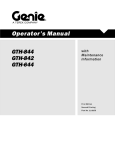
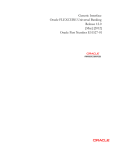

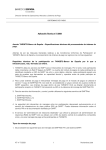


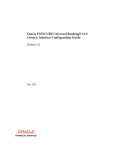
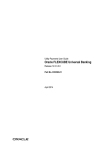

![[December] [2010] Oracle Part Number E51712-01](http://vs1.manualzilla.com/store/data/005705420_1-4b383e67b8ec6628c44005398bb7935f-150x150.png)


